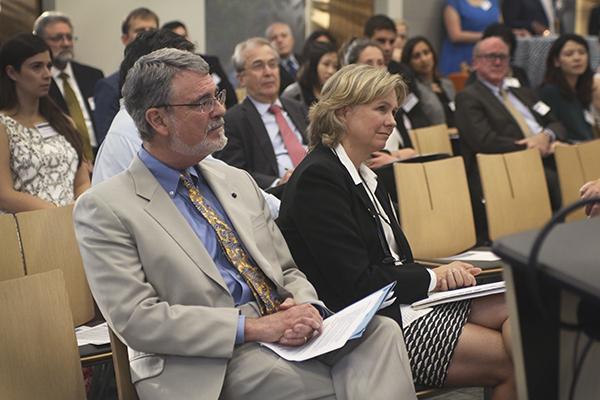A diagnosis may only be a Skype call away for some patients.
GW’s Health Workforce Institute has partnered with the Health Resources and Services Administration to tackle the medical issues of the future with a new study on the role of “telemedicine” – using audiovisual media and technology to treat patients from different locations. Using these long-distance methods, providers can help bridge the gap in the quality of care for patients in regions with underdeveloped health care systems.
Patricia Pittman, an associate professor of health policy and management and co-director of the Health Workforce Institute, said she and others at the research institute will spend the next year doing a study on how often remote health care has been used at certain underdeveloped sites sponsored by the National Health Service Corps, where health graduates offer services for a period of time in exchange for loan repayment.
The Health Workforce Institute has an agreement with HRSA worth about $2 million over the next four years to study various issues involving health systems. This year’s roughly $500,000 budget will be used primarily to research the technology-driven health care options.
GW sent out a survey in 2010 monitoring the use of telemedicine at that time. In 2015, the institute piggy-backed on a government survey to see how its use had shifted.
In 2010, less than a quarter of the health centers in the U.S. used the long-distance consultation.
Though the remote technique offers multiple benefits, including reaching underdeveloped parts of the U.S. where access to medical care isn’t guaranteed, telemedicine has gotten increasing amounts of pushback legislation-wise because of the difficulty regulating it on state and federal levels.
Pittman said that providing health care across state lines requires participation from federal and state government to solve issues like differences in medical licensing standards from state to state, as well as to decide types and amounts of insurance coverage.
“The federal level is important for Medicare payment. Medicaid payment is at the state level,” Pittman said. “In addition, the regulation of scope of practice and licensure of health professionals occurs at the state level, and this is a critical area of reform that could facilitate expanded use of telehealth.”
The program would also introduce a number of cost-saving measures. A telemedicine survey conducted by the Center for Information Technology Leadership in 2007 found that by using audiovisual measures, health centers could avoid up to 850,000 transports with an estimated savings of $537 million a year.
GW’s role in remote medicine extends beyond the research from the Health Workforce Institute. The University offers a telemedicine fellowship program for doctors completing an emergency medicine residency.
Neal Sikka, an associate professor of emergency medicine and the co-chief of GW’s innovative practice section, said that telemedicine will be an important step for making sure patients across the country are receiving the same level of medical care.
He said that since the use of this type of digital diagnosis and consultation is increasing in the workplace, medical students should become proficient in the technologies while they’re still in school.
“Graduating students and resident physicians will very likely be using telehealth in their future practice, so it is important that we start to give them tools and a foundation to be able to incorporate telehealth,” he said.
Students in the telemedicine and digital health fellowship spend two years learning the ropes with clinical practice, research, teaching and collaboration with the GW Medical Faculty Associates.
“Telehealth is a powerful tool to improve access to care for patients and a new paradigm of how we can deliver care,” Sikka said. “We hope to provide them experience that would allow them to be successful managing large-scale telehealth programs in their future practice, become innovators in the space, and work with startups and other companies that are working on new technologies to support improved health and health care access.”







